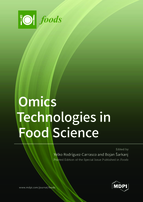Omics Technologies in Food Science
A special issue of Foods (ISSN 2304-8158). This special issue belongs to the section "Foodomics".
Deadline for manuscript submissions: closed (1 March 2022) | Viewed by 28953
Special Issue Editors
Interests: toxin; toxicity; contaminant detection; risk assessment; chromatography; spectrometry; mass spectrometry; analytical chemistry
Special Issues, Collections and Topics in MDPI journals
Interests: food safety; food microbiology; mycotoxins; antifungal susceptibility; climate change
Special Issues, Collections and Topics in MDPI journals
Special Issue Information
Dear Colleagues,
Food science has greatly developed in the last years. This has led to an increasing attention towards the origin and quality of raw materials as well as their derived food products. The endless advance in molecular biology has allowed the implementation of efficient and universal omics tools to unequivocally identify the origin of food items and their traceability. This Special Issue invites both research and review papers in the field of omics and multi-omics for food science applications. This Issue involves aspects like food safety and food quality as well as new technologies including metabolomics, metagenomics, nutrigenomics, transcriptomics, and proteomics. Obtaining and discussing new information is an important step towards the continuous research in the area of food science.
Prof. Dr. Yelko Rodríguez-CarrascoGuest Editor
Prof. Bojan Šarkanj
Co-Guest Editor
Manuscript Submission Information
Manuscripts should be submitted online at www.mdpi.com by registering and logging in to this website. Once you are registered, click here to go to the submission form. Manuscripts can be submitted until the deadline. All submissions that pass pre-check are peer-reviewed. Accepted papers will be published continuously in the journal (as soon as accepted) and will be listed together on the special issue website. Research articles, review articles as well as short communications are invited. For planned papers, a title and short abstract (about 100 words) can be sent to the Editorial Office for announcement on this website.
Submitted manuscripts should not have been published previously, nor be under consideration for publication elsewhere (except conference proceedings papers). All manuscripts are thoroughly refereed through a single-blind peer-review process. A guide for authors and other relevant information for submission of manuscripts is available on the Instructions for Authors page. Foods is an international peer-reviewed open access semimonthly journal published by MDPI.
Please visit the Instructions for Authors page before submitting a manuscript. The Article Processing Charge (APC) for publication in this open access journal is 2900 CHF (Swiss Francs). Submitted papers should be well formatted and use good English. Authors may use MDPI's English editing service prior to publication or during author revisions.
Keywords
- food safety
- food quality
- food science
- metabolomic
- transcriptomic
- proteomic
- genomic
- foodomic
- bioinformatics
- chemometrics







